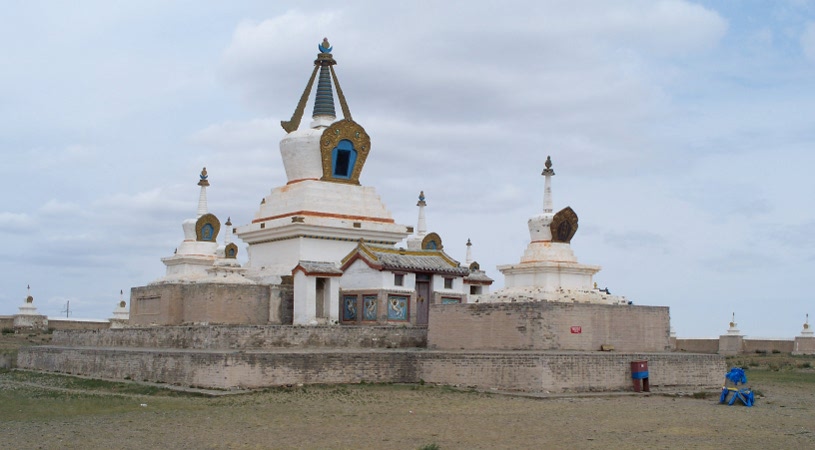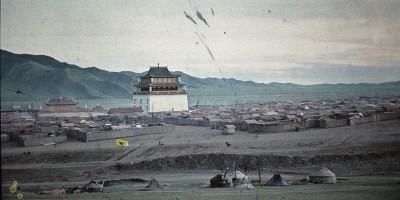It pretty much goes without argument that Mongolia is a Buddhist country. Except, when you write something like that, you inevitably start an argument. The reason, of course, is that Buddhism has a very complicated history in Mongolia, and both supporters and detractors of the religion can find reasons to quibble with the idea that Mongolian society is Buddhist.
Supporters might point out that 70 years of secular, authoritarian socialist government and the inflow of “exotic” foreign religions since the early 1990s has undermined Buddhism’s place in Mongolian society. Detractors might point out that Buddhism itself is an exotic foreign religion and has unfairly used its political influence to promote the idea it is somehow part of the core essence of what it means to be “Mongolian.”
Religion is a thorny issue, of course. It is thorny because it has two elements that can easily be confused. There is the spiritual element of religion. The philosophical tenets that are sacred, immutable, and sincere attempts at truth. This element of most religions is born from countless real world experiences and intense reflection on existential questions from great philosophical minds. Then there is the human element. The institutions that spring up around religion for political purposes which may at times be amoral, capricious, and deliberately false. This human element often uses the spiritual element as a way to leverage power. This leveraging makes discussion of religion difficult because criticism of religion usually involves attacks on the human elements with defenses mounted using the spiritual elements, so that arguments about religion can devolve into disagreements about two different things from two different perspectives.
Buddhism in Mongolia is a subject with a similar dynamic. It is hard to deny the cultural importance of Buddhism within Mongolian society, and rhetorical battles about Buddhism seem to be waged on one side by arguing the importance of its spiritual elements in defining what it means to be Mongolian and on the other side by arguing the corrosive political (i.e. human) influence Buddhism has had on Mongolian society.
The reality is not quite that simple, though. The modern constitution guarantees religious freedom. Article 9 lays out the separation of church and state. Article 16 subsection 15 establishes that people have a right to “freedom of conscience and religion.” Mongolian society is religiously tolerant and free, so Buddhism must compete in the market place of ideas with other religions. Its position in modern society is neither guaranteed as it was during the 17th, 18th, and 19th centuries nor is it under systematic attack as it was most of the 20th century. It has to succeed or fail on its merits.
Nevertheless, this fair competition still provides an opening for nationalists and religious fundamentalists to cry foul and insist Buddhism is under threat and in need of special protection to preserve Mongolian identity.1, 2 A similar argument is made almost continuously in the United States about Christianity. Political pundits like Bill O’Reilly on Fox News and his conservative predecessors going back to the founding of the republic have made good livings by turning religious freedom protected in the constitution into a conspiracy against Christianity which will lead to the ultimate doom of the country. In the United States three-quarters of Americans self-identify with some form of Christian faith.3 The First Amendment of the Bill of Rights is not part of the US constitution to undermine religion but rather to allow all ideas an equal chance in society, and even with this protection for minority religions Christianity still dominates the religious discourse in the country. Cries of majority religions under threat in religiously free societies sound purely political to me.
Mongolia is not nearly as religious as the United States. Only 61.4 percent of people over the age of 15 self-identified as having any religious faith at all in the 2010 census.4 In fact, Mongolia had over twice as many atheists as the United States with 38.6 percent claiming no religious affiliation at all.5, 6 A commonly expressed fear is the threat that “exotic” foreign religions pose to Buddhism, but 86 percent of people who identified as religious identified as Buddhist.7 So, among religious Mongolians, there really is no argument that Mongolia is a Buddhist country, just as the US is a Christian country. But if you take account of everyone who is not Buddhist, 47 percent of people do not identify with that religion.8 That fact makes the claim that Mongolia is a Buddhist country more difficult to argue.
Christian churches are quite visible in Ulaanbaatar, and the inflow of missionaries in the country since the 1990s has often made Christians, especially Mormons, the poster children for the existential threat facing Buddhism and by extension Mongolian society. It seems reasonable to make that logical leap given just a few observations. There were 140 Christian organizations to 81 Buddhist organizations operating in Ulaanbaatar in 2011.9 Some of the Christian churches are very big and exude a sense of wealth and prosperity. And, it often feels like there are only two types of foreigners in Mongolia, those prospecting for minerals and those prospecting for religious converts.
The problem with those observations is that they don’t take into account Christianity’s relative position within the market place of religious ideas, the same market place Buddhism competes. Only 41,117 people or 2.1 percent of the over 15 year old population self-identified as Christian in the census.10 That’s 14,000 less people than self-identified as “shamanistic” which is by tradition not an organized religion.11 These numbers point to a far better argument that the biggest threat to Buddhism, if it is in fact under threat, is from modern secularism. After a generation of missionary work, Christianity remains only a niche religion, and Buddhism still dominates among those who identify as religious.
All of this puts into perspective the on-going discussion in Mongolia about national identity, especially as Mongolia finds its footing with its new found mineral wealth and plays host to more and more migrant workers. What it means to be Mongolian is subject to as much interpretation and change as the countless human personalities that make up Mongolian society. To define “Mongolian” as adhering to a few cultural constructs (e.g. Buddhism, nomadism, post-communist) is to miss the exceedingly dynamic nature of Mongolian society. This dynamism is, at least for me, one of the most interesting things about living here. The country feels young and open to ideas and different ways of living. In a sense, this dynamism is the dominant feature I would use to define “Mongolian.” Being pragmatic and pursuing the best ideas rather than blind adherence to rite and ritual is arguably a hallmark of the Mongolian people going back as far as Chinggis Khaan. It is that pragmatism, which developed on the harsh frontier of the Asian steppe, that makes Mongolia feel like home because it shares similarities to American pragmatism. And, just like the definition of “American” the definition of “Mongolian” is continuously forged in the fires of conflict over progressivism versus conservatism, secularism versus religion.
So, as I began this post, Mongolia is quite obviously a Buddhist country without argument. Let the argument begin.
Footnotes
1. See example, Доржийн Сүхбаатар, “Монголын бурхны шашны сэргэлт”, http://www.news.mn/content/62057.shtml, (4/9/2011).
2. See example, М. Хангал, “Харийн шашин оюуны соёлыг устгаж байна”, http://www.olloo.mn/modules.php?name=News&file=article&sid=1161048, (9/30/2009).
3. The Pew Forum on Religion and Public Life, “US Religous Landscape Survey”, http://religions.pewforum.org/affliiations.
4. National Statistics Office, “2010 Census Main Results”, http://www.toollogo2010.mn/doc/Main%20results_20110615_to%20EZBH_for%20print.pdf, slide 34.
5. Ibid.
6. The Pew Forum on Religion and Public Life, “US Religous Landscape Survey”, http://religions.pewforum.org/affliiations.
7. National Statistics Office, “2010 Census Main Results”, http://www.toollogo2010.mn/doc/Main%20results_20110615_to%20EZBH_for%20print.pdf, slide 34.
8. Ibid.
9. Capital Statistics Office, “Religious Organizations Operating in the Capital”, http://ubstat.mn/Upload/Reports/niisleliin_shashnii_baiguullaguud_2011_ond_ulaanbaatar_2012-11.pdf, pg. 2.
The Pew Forum on Religion and Public Life, “US Religous Landscape Survey”, http://religions.pewforum.org/affliiations.
10. National Statistics Office, “2010 Census Main Results”, http://www.toollogo2010.mn/doc/Main%20results_20110615_to%20EZBH_for%20print.pdf, slide 34.
11. Ibid.



